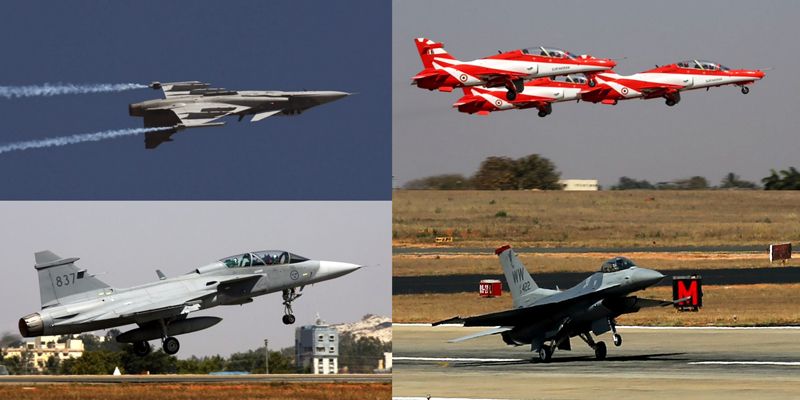Policy on defence offsets create upsets, Aero India 2017 remains dull
The government's Make in India push and offsets policy do not seem to have gone down well with the global aerospace and defence players.
The Indian defence offsets clause is believed to have put off international aerospace and defence majors, leading to a poor response and absence of big names from the just-concluded Aero India 2017 at Bengaluru.

Though India is the world’s largest importer of military hardware in the last five years, according to the Stockholm International Peace Research Institute, the 30-percent offsets rider for winning big-ticket contracts appears to have unnerved top global aerospace and defence players, barring a few from Europe.
These foreign majors are already battle-weary after the US-sponsored restrictions on sale of technology to third parties. When India bought three Embraer business jets for the Indian Air Force for VVIP duties, the Brazilian aircraft maker could not fulfil its contractual obligations of fitting the aircraft with a protection suite, as the US and Brazil had an agreement barring the selling of such sensitive defence technology to a third country. India and Brazil had to lobby hard with the US to win an exemption.
Things have not gone down well with technology providers, now with Make in India, and what is being seen as a sterner government keen to implement the offsets policy compared to the past decade, when the UPA was in power.
Offsets policy essentially means benefits that a buyer gets from the seller in the form of technology that leads to building capability or capacity locally. Indian industry is expected to gain from a foreign vendor. The policy on offsets was first introduced as part of Defence Procurement Procedure in 2005 and has undergone various changes since. In November last year, the Defence Acquisition Council raised the offset baseline’s monetary value to Rs 2,000 crore from Rs 300 crore.
The objective of the policy broadly is to leverage capital acquisitions to develop the fledgling Indian defence industry. Apart from laying down the rules for foreign sellers, the government has also rejigged the DPP into three categories to encourage Make in India – Make I involves 90-percent funding of the development by government; under Make II, the government will refund 100 percent development cost in case the product is not bought, and Make III has been reserved for small and medium enterprises to give this sector a thrust.
For foreign suppliers, offsets mean a burden. According to a US industry head who did not wish to be named,
Here, it means, we have to be fully satisfied with the Indian partner’s capability, which is like a fresh test and rolling back years that have already been lost due to haggling and blacklisting foreign companies by India. We have also consistently been raising the capability question of skilled hands. It is not all about manufacturing prowess of an entity making a fuselage or an aircraft body frame, but passing stringent quality checks of making products that go into the aircraft, such as navigation, weapons and electronics, which have been developed abroad. Patented products too pose a problem as sharing these will lead to an escalation in costs.”
He was clearly speaking of the Americans still being upset about losing out a lucrative fighter jet contract to the French. The F-16 and F-18 Hornets were in the race along with Rafale, Typhoon and Saab Gripen, which eventually Rafale won a part of.
But, Ray Challis, Head of Sales and Marketing for UK-based Ultra Electronics, says the company has already signed an MoU with Mahindra Defence for manufacturing systems for the Indian Navy. “Ultra is a pioneer in precision control system and has a global supply chain. We are willing to bet on a 100-percent transfer of technology if need be. India has problems that we have already solved in Brazil and the US and it is our endeavour to partner with local companies here in India,” Challis told YourStory at Aero India 2017 UK Pavilion.
Fraser Hamilton, Vice President, Global Alliances, for Boxaar, which has developed a systems management software to quicken defence processes, from manufacturing to submarine management, says India is an exciting market. Echoing UK Minister for Defence Procurement Harriett Baldwin's sentiment, he says, “The UK may be leaving the EU, but we are stepping up our engagement elsewhere. India and the UK are an unbeatable combination in defence and aerospace.”
So far, it was only Hindustan Aeronautics Limited (HAL) or a single entity that foreign companies dealt with and were happy to enter into a JV. But things are changing now. The UK earlier this week announced partnerships with Mahindra and L&T and more such are in the works.
Besides, there is no clarity on how to break down the 30 percent in exact terms. “If we bring in the core from a factory abroad to be assembled as part of a larger piece made in India, we will still have customs barriers. This particular question is true of the automobile industry and has been hurting Volvo and Scania while competing with Ashok Leyland and Tata in the domestic bus market. It has not been spelt out clearly,” rues a trade delegation head from Scandinavia.
Defence Minister Manohar Parrikar is not unduly bothered. He has been proudly informing that of the Rs 96,000 crore worth of equipment bought for the armed forces this year, for the first time, his ministry placed Rs 92,000 crore worth of orders from indigenous manufacturers, which included a bulk of defence public sector units.
But the irony is that there are a lot of ongoing projects as well as a long wishlist of things to be ordered yet. Ongoing projects include submarine building, advance early warning aircraft, Rafale fighters, missiles, missile shields, aerostat radars, all of which already signed for and delivery schedules have begun. The wishlist includes multi-role combat fighters, basic and intermediate jet trainer, attack helicopters, drones, infantry clothing and weapons, artillery guns, gun-mounted turrets for tanks, improved electronics and sat-nav equipment for all three services and a host of equipment to modernise the forces.

The Defence Research and Development Organisation labs spread across the country are engaged in a parallel complementary research programme for every piece of imported equipment. Except for INSAS rifles, Light Combat Aircraft, Dhruv copters and tanks, licensed production of thousands of R&D products from the DRDO stable are still a long way off.
Former HAL chairman A.K. Saxena believes that signing a series of joint ventures is the easiest way to propel the offsets clause while Baba Kalyani, Chairman, Bharat Forge, says they need to see order books filling up, otherwise defence manufacturing will not pick up pace. “Once Make in India begins bearing fruit, we will be manufacturing six times the current scale,” he told a Make in India -- Karnataka conference recently.
Whether the offsets clause, which has upset the world at large, will rob the sheen off the Make in India obsession remains to be seen.








